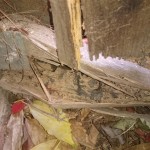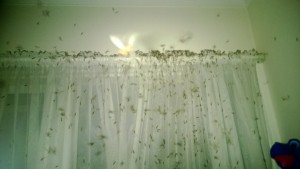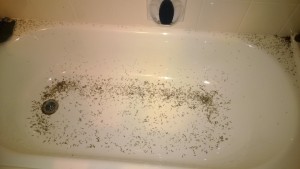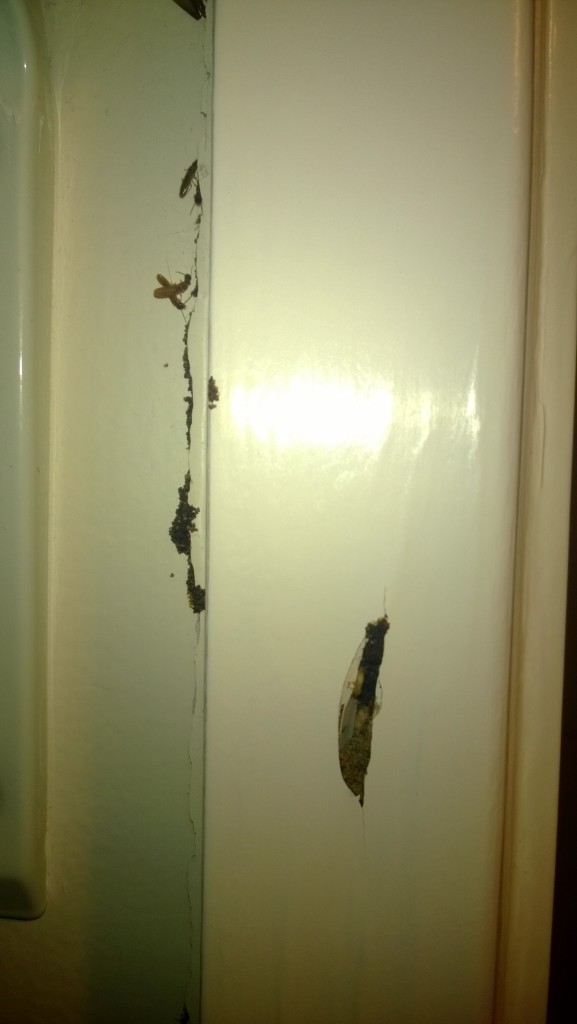The Flight of the Termite: The Silent Intruder

Many Canberrans are shocked to learn the ACT has a growing termite problem, and it’s one that should not be ignored.
A major termite flight took place inside a Canberra home, with the termites determined to find a place to build a new nest.

Swarms of termites invading a house from which they have come through an internal wall as part of a termite flight
The CSIRO recommends that houses be inspected for termites at a minimum annually. These pests—the most destructive in the world—can quickly and quietly munch through a house causing many thousands of dollars’ worth of damage. An annual termite inspection costs as little as $270 to $350 and can save owners a small fortune.
Termites are increasingly active in Canberra. They are frequently found when inspecting Canberra homes, with many owners distressed to learn their house, fences or landscaping timbers are affected. The change in weather patterns over time in the ACT has contributed to a rise in termite activity every year since at least 2005.
In one recent incident, a property manager called a reputable inspector after an alarming call from a tenant who thought they had a bunch of bugs flying in their house. It ended up being a huge flight of termites that had burst through an internal wall and had damaged the structure.
So how do you get on top of a potential termite problem?
The only way to be sure is to use a professional termite specialist who has a trained eye. Termites are very hard to see and can be difficult to find, but in as little as three months they can severely damage almost all the timber in a property. You need ongoing annual checks to keep on top of matters. In some instances, inspections should be carried out more frequently depending on the risks associated with the property, and its location.
Here are some signs of termite infestation:
- Mud leads, which are tunnels made of mud. They usually appear on the outside of your house, subfloor, or roof void, including on brickwork or concrete. Termites travel through these tunnels.
- Timber with gaps and holes that crumbles when touched.
- Damaged wood, especially when the wood makes a dull thud when you strike it with something hard, such as a hammer or your vacuum cleaner.
- Swarms of what look like ants flying in and around your house. You may get the odd one in your house, and that generally is not a problem as they have just come in from outside on a humid evening. It’s more when they come in swarms as this is an indication that they could have come from inside the house.
- Noises in the wall. If you hear strange noises while lying in bed, it doesn’t mean you’re crazy; it could very well be termites. Termites do something called “headbanging” which is a way for them to communicate when they feel threatened. They literally bang their heads together. Want to hear what this sounds like? Check out this audio.
With a professional inspection, make sure you ask how the inspection will be performed and remember that it should take any quality inspector a minimum 1.5 hours to work carefully through a three-bedroom home with a subfloor.
This is not a process that should be rushed. You need the inspector to assess current termite activity, any damage, the history of activity and risks. You may also need a detailed management plan to deal with identified risks.
Most importantly take the time to chat with the inspectors after the inspections and determine what you can do to reduce your overall risk and learn what you can to watch your property between regular inspections.
Tags: pest control, temites Queanbeyan, termite facts, termite infestation, termites, termites batemans bay, termites canberra, white ants



